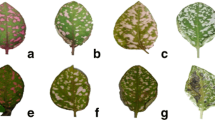Abstract—
The reactions to ozone of the surface cells of leaves and needles of five introduced wood species of Sochi National Park in chronic 3-day exposure in total doses of up to 0.05 μL/L have been studied. In secretory structures of silvery or ashen leaves of Eucalyptus cinerea F. Muell. Ex. Benth, we observed noticeable changes in absorbance (fading) and autofluorescence in cells. Blue and silvery needles of Picea pungens Engelm species. cv. Sv, Cedrus atlantica (Endl.) Manetti ex Carrière cv. Argentea, Pinus parviflora Siebold &Zucc. Glauca and leaves of Acacia dealbata Link. were not sensitive to ozone in the above-mentioned reactions. It was shown that the surface layers of the cuticle and cell wall of these plants included azulenes. These pigments are supposed to be primary targets for ozone, and their antioxidant properties determine low sensitivity to ozone.






Similar content being viewed by others
REFERENCES
Ernst D., Jürgensen M., Bahnweg G., Heller W., Müller-Starck G. 2012. Common links of molecular biology with biochemistry and physiology in plants under ozone and pathogen attack. In: Growth and Defense in Plants. Eds. Matyssek R., Schnyder H., Oßwald W. Heidelberg, New York: Springer, p. 29–51.
Pearson M. 1995. Effects of ozone on growth and gas exchange of Eucalyptus globulus seedlings. Tree Physiology. 15 (3), 207–210.
Pell E.J., Schlagnhaufer C.D., Arteca R. N. 2006. Ozone-induced oxidative stress: Mechanisms of action and reaction. Phisiologia Plantarum. 100 (2), 264–273.
Roshchina V.V., Roshchina V.D. 2003. Ozone and plant cell. Dordrecht: Kluwer.
Roshchina V. V. 2020. How tropospheric ozone influences the allelopathy of woody species: some experimental approaches. J. Plant Sciences. 8 (4), 71–79.
Roshchina V.V., Soltani G.A. 2020. Effects of ozone (O3) on leaf secretory cell characteristics related to allelopathy of woody plants: Modelling allelopathic interactions. Allelopathy Journal. 51 (2), 209–220.
Roshchina V.V., Khaibulaeva L.M., Prizova N.K., Kuchin A.V., Soltani G.A., Kunyev A.R.2021. Sensitivity to ozone of plant surface cells as sensors. In: Receptors and Intracellular Signaling. Eds. Zinchenko V.P. and Berezhnov A.V., Pushchino 21–23 May 2021. Vol. 2, p. 581–587.
Budantsev A.Yu., Roshchina V.V. 2020. Enzymatic tissue biotests (MAO and AChE biotests) and bioindicators. In: Macro, micro, and nano-biosensors. Eds. Rai, M., Reshetilov, A., Plekhanova, Y., Ingle, A.P. Cham, Switzerland: Springer Int. Publ. Ag., p. 37–55.
Monk R.J., Murray F. 1995. The relative tolerance of some Eucalyptus species to ozone exposure. Water Air Soil Pollut. 85, 1405–1411.
Townsend A.M., Dochinger L.S. 1982. Relative sensitivity of pine species to ozone. J. Arboriculture. 8 (7), 186–188.
Konovalov D.A. 1995. Natural azulenes. Plant Resources. 31 (1), 101–130.
Roshchina V.V., Melnikova E.V., Spiridonov N.A., Kovaleva L.V. 1995. Azulenes, the blue pigments of pollen. Dokl. Biol. Sci. 340 (1), 93–96.
Roshchina V.V., Melnikova E.V., Yashin V.A., Karnaukhov V.N. 2002. Autofluorescence of intact horsetail spores Equisetum arvense L. in the process of development. Biophysics. 47 (2), 318–324.
Heilbronner E. 1959. Azulenes. In: Non-benzenoid aromatic compounds. Ed. D.Ginsburg. New York, London: Intersci. Publ. p. 171–276.
Nakagawa S., Katoh K., Kusumi T., Komura H., Nomoto K., Konno H., Huneck S., Takeda R. 1992. Two azulenes produced by liverwort, Calypogeia azurea, during in vitro culture. Phytochemistry. 31 (5), 1667–1670.
Siegel U., Mues R., Dönig R., Eicher Th., Blechschmidt M., Becker H. 1992. Ten azulenes from Plagiochila longispina and Calypogeia azurea. Phytochemistry. 31 (5), 1671–1678.
Roshchina V.V. 1999. Mechanisms of cell–cell communication. In: Allelopathy Update. Ed. Narwal. S.S., Delhi, Calcutta: Oxford and IBH Publ, Vol. 2, p. 1–25.
Muir R.M., Hansch C. 1961. Azulene derivatives as plant growth regulators. Nature. 190, 741–742.
Bakun P., Czarczynska-Goslinska B., Goslinski T., Lijewski S. 2021. In vitro and in vivo biological activities of azulene derivatives with potential applications in medicine. Med. Chem. Res. 30, 834–846.
Shoji T., Okujima T., Ito S. 2020. Development of heterocycle-substituted and fused azulenes in the last decade (2010–2020). Int. J. Mol. Sci. 21, 7087–709.
Roshchina V.V., Yashin V.A., Vikhlyantsev I.M. 2012. Fluorescence of plant microspores as biosensors. Biochem. (Moscow), Suppl. Series A: Membr. Cell Biol. 6 (1), 105–112.
Löber S., Hübner H., Buschauer A., Sanna F., Argiolas A., Melis M.R., Gmeiner P. 2012. Novel azulene derivatives for the treatment of erectile disfunction. Bioorg. Med. Chem. Lett. 22, 7151–7154.
Sweet L.I., Meier P.G. 1997. Lethal and sublethal effects of azulene and longifolene to microtox R Ceriodaphnia dubia, Daphnia magna, and Pimephales pro-melas. Bull. Environ. Contam. Toxicol. 58, 268–274.
Sizova N.V. 2012. Composition and antioxidant activity of essential oils containing azulene derivatives. Pharm. Chem. J. 46 (6), 369–371.
Funding
The work was carried out within the state program of basic scientific research (GP 14) on the topic (project) 61.3. (0191-2019-0022), registration number AAAA-20-120101390067-0.
Author information
Authors and Affiliations
Corresponding author
Ethics declarations
The authors declare that they have no conflict of interest. This article does not contain any studies involving animals or human participants performed by any of the authors.
Additional information
Translated by V. Roshchina
Rights and permissions
About this article
Cite this article
Roshchina, V.V., Kuchin, A.V., Kunyev, A.R. et al. The Presence of Azulene on the Surface of Plant Cells as a Test for Ozone Sensitivity. Biochem. Moscow Suppl. Ser. A 16, 167–174 (2022). https://doi.org/10.1134/S1990747822010081
Received:
Revised:
Accepted:
Published:
Issue Date:
DOI: https://doi.org/10.1134/S1990747822010081




